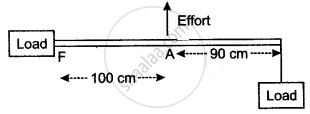Advertisements
Advertisements
Question
The following belong to which class of lever?
Nutcracker
Solution
Second-class of lever
APPEARS IN
RELATED QUESTIONS
The diagram below shows a lever in use:

- To which class of levers does it belong?
- Without changing the dimensions of the lever, if the load is shifted towards the fulcrum what happens to the mechanical advantage of the lever?
Write down a relation expressing the mechanical advantage of a lever.
The following belong to which class of lever?
A see-saw
The following belong to which class of lever?
Pliers Tools
The following belong to which class of lever?
A claw-hammer
Shears, used for cutting metals and scissors used for cutting clothes are both examples of levers of the first order. However, whereas the shears always have short blades and long handles, the scissors often have blades much longer than the handles. Explain, why this is so?
The following are an example of levers. State the class of lever to which each one belongs giving the relative positions of Load (L), Effort (E), Fulcrum (F):
(i) Scissors (ii) Sugar tongs (iii) Nutcracker (iv) Pliers.
The diagram shows the use of a lever.

- State the principle of moments as applied to the above lever.
- Which class of lever is this? Give an example of this class of lever.
- If FA = 100 cm, AB = 90 cm, calculate the minimum effort required to lift the load.
State the types (or kinds) of lever, and give two examples of each kind.
A crowbar of length 100 cm is used to lift a load of 5 kgf. It has its fulcrum at a distance of 20 cm from the load. Calculate:
(i) the mechanical advantage of a crowbar and,
(ii) the effort applied at the other end.
